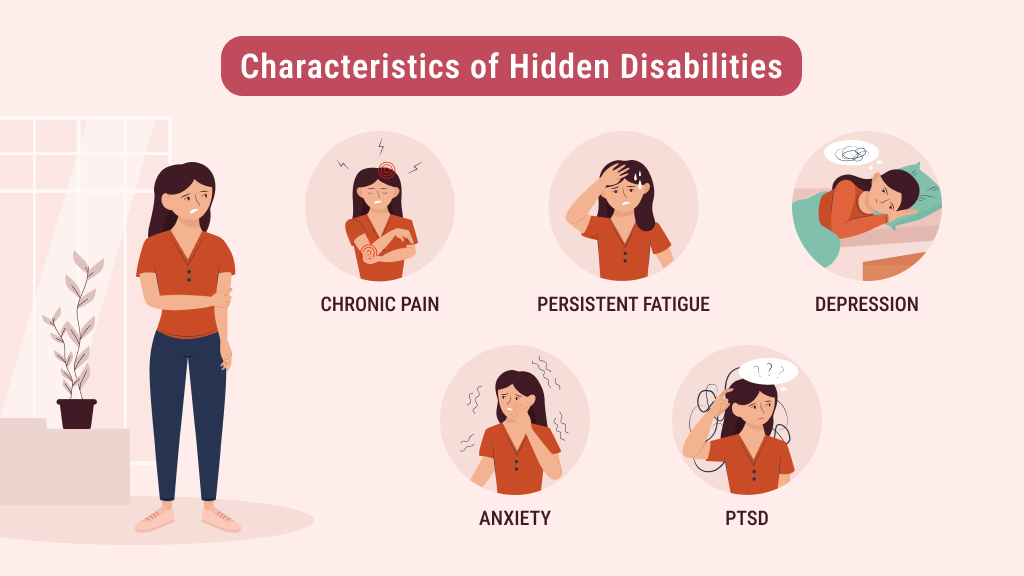Seeing someone in a wheelchair or using assistive technology is a clear indicator that they have a disability. However, not all disabilities are as obvious as this.
A study by the Center for Talent Innovation (1) shows that around 30 percent of all college-educated employees have a disability, 62 percent of which are invisible disabilities.
Numerous people go about their daily lives without knowing or disclosing that they have a disability that impacts them physically, emotionally, and mentally.
Whether you want to learn more about invisible disabilities or determine whether you might have one, this blog has the information you need.
A hidden disability is often described as an ongoing mental or physical challenge that is not immediately obvious to the eye.
People living with these subtle challenges are still fully active in their day-to-day lives but can find it more difficult to get through the day. Along with struggling with daily living activities, someone with a hidden disability may also find it difficult to gain and maintain employment.
According to the Americans with Disabilities Act (ADA), a physical or mental impairment that limits one or more major life activities is considered a disability. However, a disability can also be described as living with a challenge that makes it difficult to perform certain functions such as completing tasks at work, doing household chores, and assisting a child with homework.
The fact that countless people are struggling with the basics daily without an explanation is why it’s so important to raise awareness about invisible disabilities.

Silent disabilities have a range of characteristics, which is why it’s not always easy to identify them.
An individual with an invisible disability may experience chronic pain, persistent fatigue, depression, anxiety, and PTSD. Other chronic conditions such as diabetes can also fall into this category.
And even though they are more pronounced, eyesight, hearing, learning, and cognitive impairments are also symptoms linked to invisible disabilities.
There are literally thousands of illnesses, disorders, dysfunctions, impairments, and injuries that can make day-to-day life much harder.
It would be difficult to compile a complete list of invisible disabilities, purely because there are so many, but here are some of the top examples:
We all encounter people with silent disabilities every day without knowing it, but there are ways that you can make a difference in their lives.
It can take a lot of courage to disclose a disability, so if someone does open up to you, it’s important to respond mindfully. Telling someone with an invisible disability that they don’t look sick or it could be worse is not appropriate or necessary. Instead, thank them for sharing this information with you and ask if there is something you can do to better support them.
When someone doesn’t immediately look like they have a disability, it’s easy to get angry when you see them using accessible amenities such as parking spaces. Before you judge anyone at a surface level, consider the fact that you have no idea what they’re experiencing and what they need to make their lives easier.
A person with a silent disability has more than likely been trying to “fit in” their entire lives. When someone doesn’t respond or act in a way that you think is ‘normal’, consider whether there is an underlying cause before passing judgment. For example, someone who cannot maintain eye contact or gets irritable in a loud, busy room could have autism, which makes something as simple as a conversation more trying.
Employers should also do their part to cater to the disabled community, regardless of whether the impairment is obvious or not. For one, it’s important to make all employees feel comfortable disclosing a disability. Communicating your disability inclusion policies is one way to do this. You also want to evaluate the type of accommodations your business offers for the disabled. Along with physical accessibility, making accommodations for people with cognitive or learning disabilities can go a long way in building a stronger workforce.
If you don’t already, find ways for your business to offer more support to disabled employees. Driving awareness of all types of disabilities and impairments can make disabled staff feel more comfortable and help other employees better understand these challenges. Other ways that you can offer support is by implementing mental health coverage in your insurance plans and even providing life coaching. An inclusive workplace is one where people feel more supported and motivated.
Understanding invisible disabilities and how they can impact daily life can help build more inclusive communities where everyone is supported. A silent disability doesn’t need to be limiting – having a fulfilling personal and working life is possible.
Speak to a healthcare professional if you feel that you might be living with an invisible disability. And if you’ve already been diagnosed, reach out to the people around you to ensure you have the support you need.
According to the Center for Disability Rights, ADHD is categorized as an invisible disability. ADHD can impact an individual’s ability to perform certain tasks such as studying, being still, and working at the same level as the average person. Because it’s not always possible to determine whether someone has ADHD, it is seen as a silent disability.
Obsessive compulsive disorder (OCD) causes patterns of unwanted thoughts and obsessions that lead to repetitive behavior, behavior that can make daily life activities more challenging. Because of this OCD is categorized as a hidden disability.